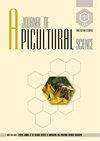Nest Structure, Development and Natural Enemies of Ceratina hieroglyphica Smith, A Stem Nesting Bee Colonizing Cashew Trees in Hilly Terrains
IF 0.8
4区 农林科学
Q4 ENTOMOLOGY
引用次数: 6
Abstract
Abstract Ceratina hieroglyphica nesting sites were located in dried tiny twigs of cashew trees, and the life stages were observed through periodical collection of nests. Nests were located in the pithy region up to a maximum of 20 cm deep, and individual cells of 3.5 4 mm were separated by partitions. In 2017, one hundred and two nests were collected, of which twenty-two had been abandoned. Older cells were at the bottom of nests, while young ones towards the entrance. Among the different stages, the most in the nests were adults (51.8%), followed by pupal stages. Periodical collection of nests and the observations on developmental stages of the bees indicated that the nesting period was found to occur between October and March. Each egg was laid on a pollen provision located in separate cells and the incubation period lasted for 3.1±0.29 days. The larval period and pupal period lasted for 8.4±0.63 days and 7.3±01.41 days, respectively. Adults survived up to fourteen days in lab conditions with 10% honey solution. Parasitoids, predators and pathogens recorded on this bee species are also presented here.山地腰果树茎巢蜂巢结构、发育及天敌研究
摘要将象形角角虫筑巢地点定位在腰果树干燥的细枝上,通过定期采巢观察其生命阶段。巢位于茎髓区,深度最大可达20 cm,单个细胞间隔3.5 - 4 mm。2017年,收集了102个鸟巢,其中22个已被遗弃。较老的细胞在巢的底部,而年轻的细胞在巢的入口处。在不同阶段,巢中以成虫居多(51.8%),其次为蛹期。定期采巢和对蜜蜂发育阶段的观察表明,蜜蜂的筑巢期在10月至3月之间。每个卵产于位于单独细胞的花粉上,孵育期为3.1±0.29 d。幼虫期为8.4±0.63 d,蛹期为7.3±01.41 d。在实验室条件下,在10%的蜂蜜溶液中,成虫可以存活14天。本文还介绍了该蜜蜂的拟寄生物、捕食者和致病菌。
本文章由计算机程序翻译,如有差异,请以英文原文为准。
求助全文
约1分钟内获得全文
求助全文
来源期刊

Journal of Apicultural Science
ENTOMOLOGY-
CiteScore
1.70
自引率
0.00%
发文量
9
审稿时长
>12 weeks
期刊介绍:
The Journal of Apicultural Science is a scientific, English-language journal that publishes both original research articles and review papers covering all aspects of the life of bees (superfamily Apoidea) and broadly defined apiculture. The main subject areas include:
-bee biology-
bee genetics-
bee breeding-
pathology and toxicology-
pollination and bee botany-
bee products-
management, technologies, and economy-
solitary bees and bumblebees
 求助内容:
求助内容: 应助结果提醒方式:
应助结果提醒方式:


